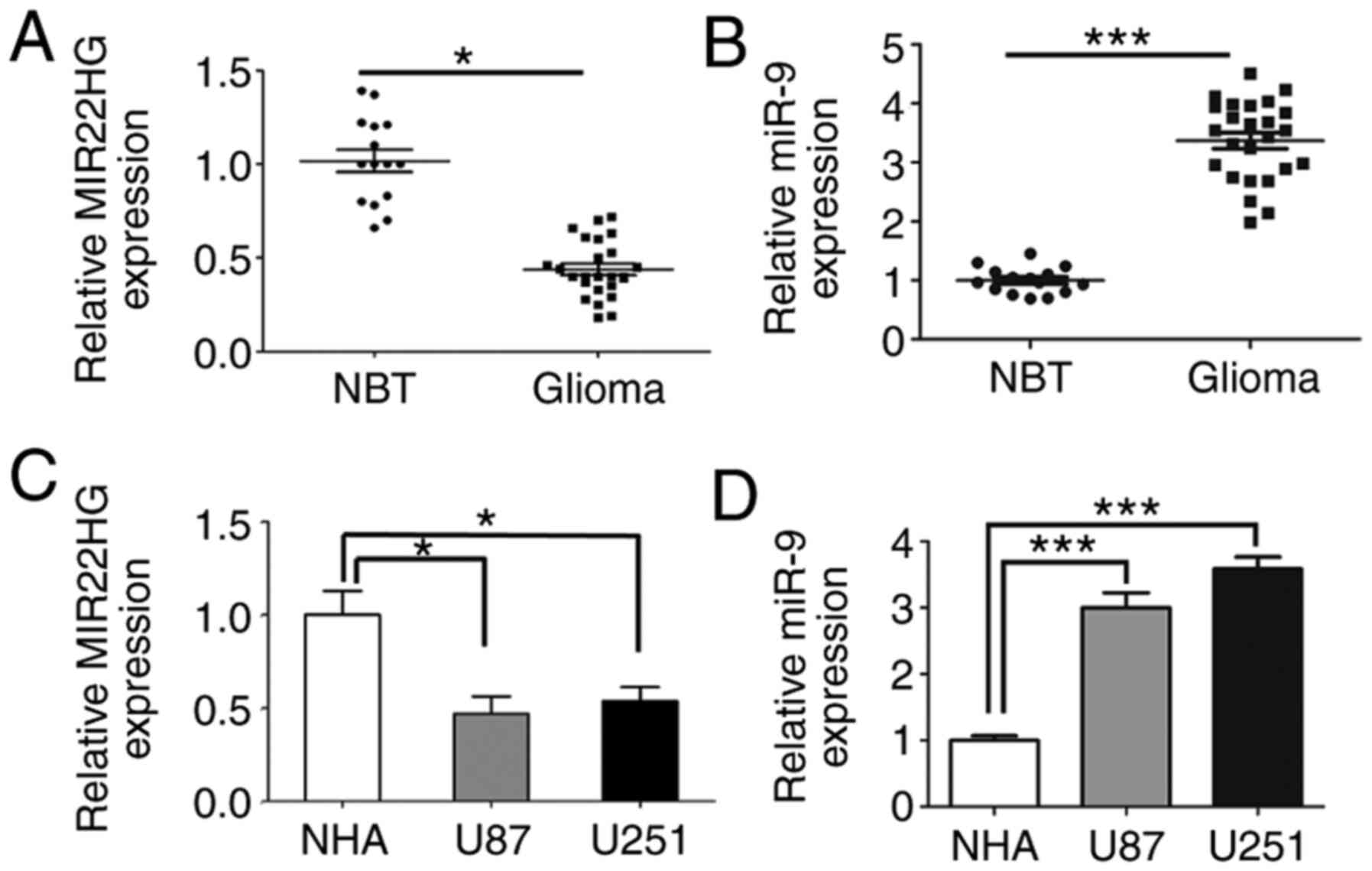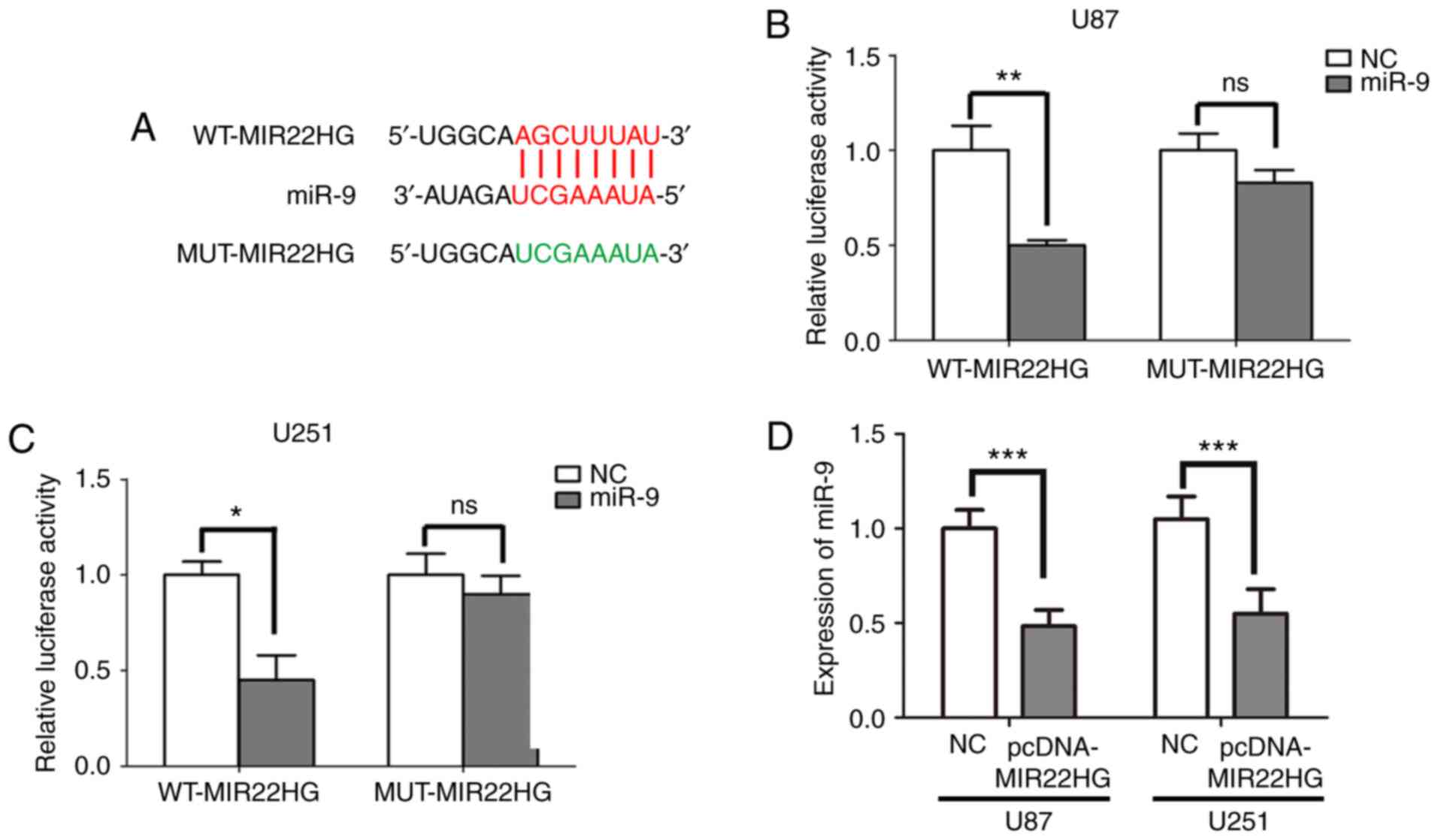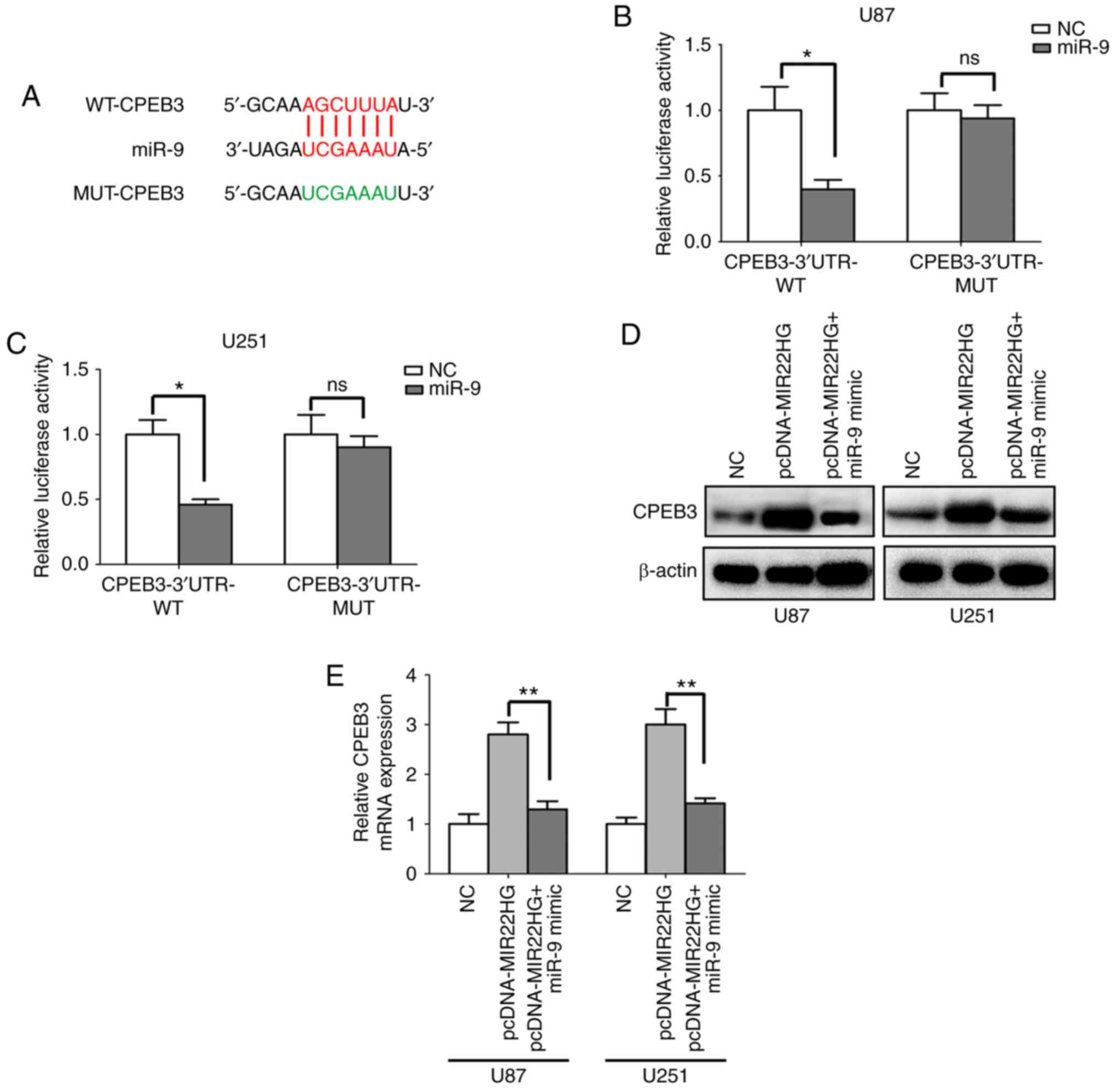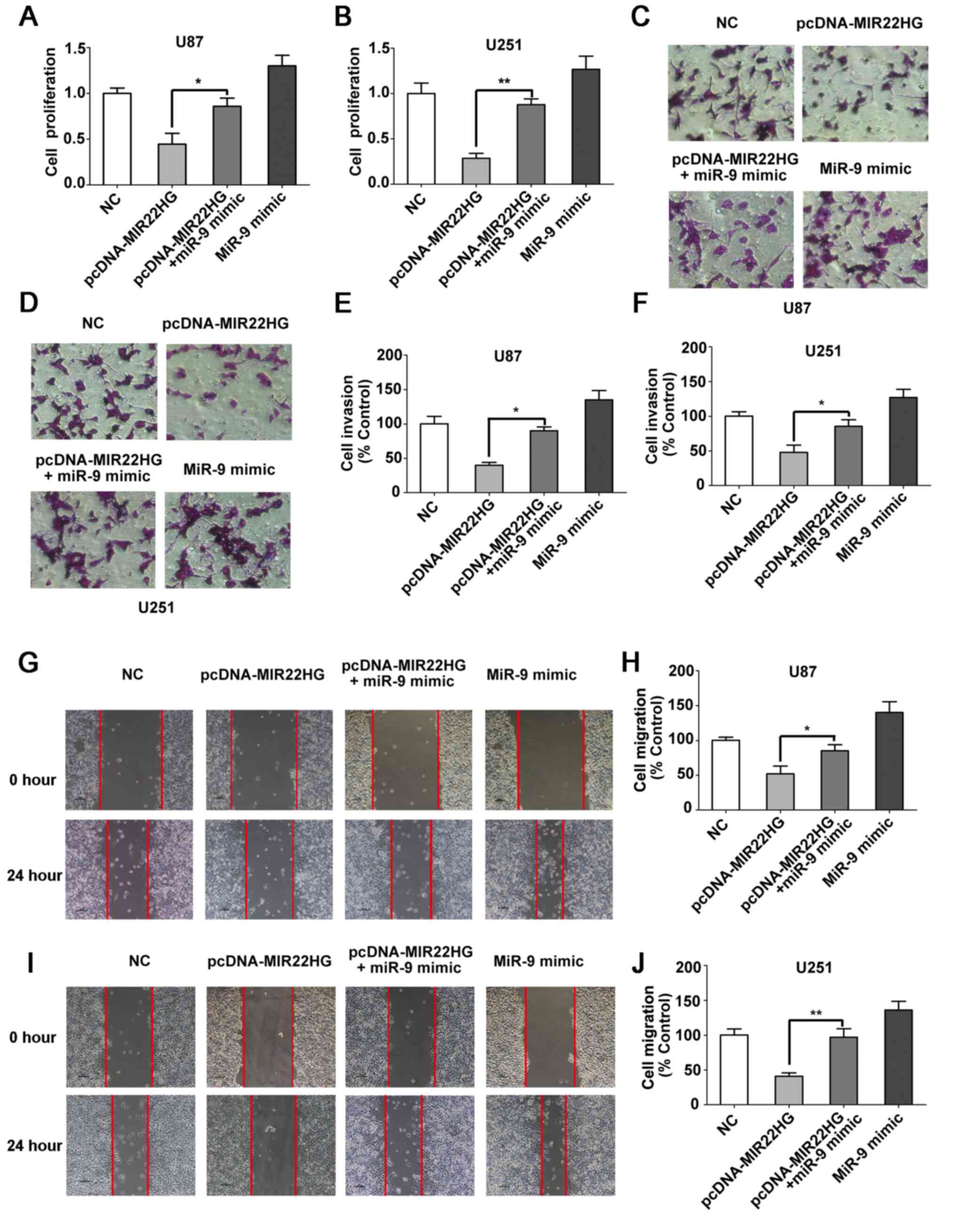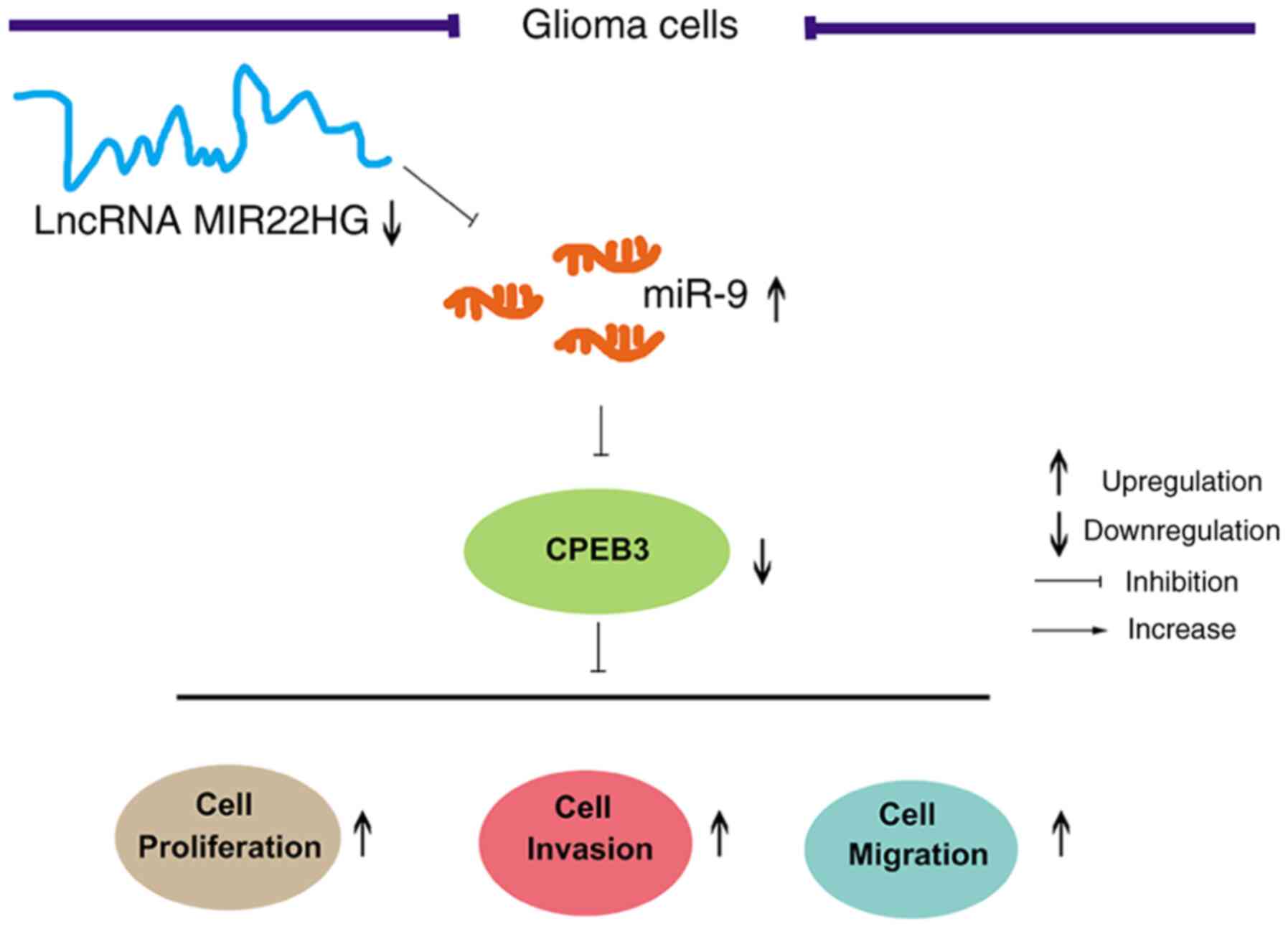|
1
|
Lv D, Li Y, Zhang W, Alvarez AA, Song L,
Tang J, Gao WQ, Hu B, Cheng SY and Feng H: TRIM24 is an oncogenic
transcriptional co-activator of STAT3 in glioblastoma. Nat Commun.
8:14542017. View Article : Google Scholar : PubMed/NCBI
|
|
2
|
Liu X, Zheng J, Xue Y, Qu C, Chen J, Wang
Z, Li Z, Zhang L and Liu Y: Inhibition of TDP43-mediated
SNHG12-miR-195-SOX5 feedback loop impeded malignant biological
behaviors of glioma cells. Mol Ther Nucleic Acids. 10:142–158.
2018. View Article : Google Scholar : PubMed/NCBI
|
|
3
|
Ostrom QT, Bauchet L, Davis FG, Deltour I,
Fisher JL, Langer CE, Pekmezci M, Schwartzbaum JA, Turner MC, Walsh
KM, et al: The epidemiology of glioma in adults: A ‘state of the
science’ review. Neuro Oncol. 16:896–913. 2014. View Article : Google Scholar : PubMed/NCBI
|
|
4
|
Zhou S, Ding F and Gu X: Non-coding RNAs
as emerging regulators of neural injury responses and regeneration.
Neurosci Bull. 32:253–264. 2016. View Article : Google Scholar : PubMed/NCBI
|
|
5
|
Van Meir EG, Hadjipanayis CG, Norden AD,
Shu HK, Wen PY and Olson JJ: Exciting new advances in
neuro-oncology: The avenue to a cure for malignant glioma. CA
Cancer J Clin. 60:166–193. 2010. View Article : Google Scholar : PubMed/NCBI
|
|
6
|
Yuan X, Curtin J, Xiong Y, Liu G,
Waschsmann-Hogiu S, Farkas DL, Black KL and Yu JS: Isolation of
cancer stem cells from adult glioblastoma multiforme. Oncogene.
23:9392–9400. 2004. View Article : Google Scholar : PubMed/NCBI
|
|
7
|
Lino MM, Merlo A and Boulay JL: Notch
signaling in glioblastoma: A developmental drug target? BMC Med.
8:722010. View Article : Google Scholar : PubMed/NCBI
|
|
8
|
Schwartzbaum JA, Fisher JL, Aldape KD and
Wrensch M: Epidemiology and molecular pathology of glioma. Nat Clin
Pract Neurol. 2:494–503, 1–516. 2006. View Article : Google Scholar : PubMed/NCBI
|
|
9
|
Ostrom QT, Gittleman H, Stetson L, Virk SM
and Barnholtz-Sloan JS: Epidemiology of gliomas. Cancer Treat Res.
163:1–14. 2015. View Article : Google Scholar : PubMed/NCBI
|
|
10
|
Huarte M: The emerging role of lncRNAs in
cancer. Nat Med. 21:1253–1261. 2015. View
Article : Google Scholar : PubMed/NCBI
|
|
11
|
Wang Y and Lee CG: MicroRNA and
cancer-focus on apoptosis. J Cell Mol Med. 13:12–23. 2009.
View Article : Google Scholar : PubMed/NCBI
|
|
12
|
Wang X, Yu H, Sun W, Kong J, Zhang L, Tang
J, Wang J, Xu E, Lai M and Zhang H: The long non-coding RNA CYTOR
drives colorectal cancer progression by interacting with NCL and
Sam68. Mol Cancer. 17:1102018. View Article : Google Scholar : PubMed/NCBI
|
|
13
|
Kopp F and Mendell JT: Functional
classification and experimental dissection of long noncoding RNAs.
Cell. 172:393–407. 2018. View Article : Google Scholar : PubMed/NCBI
|
|
14
|
Fu J, Dong G, Shi H, Zhang J, Ning Z, Bao
X, Liu C, Hu J, Liu M and Xiong B: LncRNA MIR503HG inhibits cell
migration and invasion via miR-103/OLFM4 axis in triple negative
breast cancer. J Cell Mol Med. 23:4738–4745. 2019. View Article : Google Scholar : PubMed/NCBI
|
|
15
|
Zhang S and Guo W: Long noncoding RNA MEG3
suppresses the growth of glioma cells by regulating the
miR965p/MTSS1 signaling pathway. Mol Med Rep. 20:4215–4225.
2019.PubMed/NCBI
|
|
16
|
Li C, Tan F, Pei Q, Zhou Z, Zhou Y, Zhang
L, Wang D and Pei H: Non-coding RNA MFI2-AS1 promotes colorectal
cancer cell proliferation, migration and invasion through
miR-574-5p/MYCBP axis. Cell Prolif. 52:e126322019. View Article : Google Scholar : PubMed/NCBI
|
|
17
|
Zhao X, He M, Wan D, Ye Y, He Y, Han L,
Guo M, Huang Y, Qin W, Wang MW, et al: The minimum LOH region
defined on chromosome 17p13.3 in human hepatocellular carcinoma
with gene content analysis. Cancer Lett. 190:221–232. 2003.
View Article : Google Scholar : PubMed/NCBI
|
|
18
|
Zhang DY, Zou XJ, Cao CH, Zhang T, Lei L,
Qi XL, Liu L and Wu DH: Identification and functional
characterization of long non-coding RNA MIR22HG as a tumor
suppressor for hepatocellular carcinoma. Theranostics. 8:3751–3765.
2018. View Article : Google Scholar : PubMed/NCBI
|
|
19
|
Li H and Wang Y: Long noncoding RNA
(lncRNA) MIR22HG suppresses gastric cancer progression through
attenuating NOTCH2 signaling. Med Sci Monit. 25:656–665. 2019.
View Article : Google Scholar : PubMed/NCBI
|
|
20
|
Cui Z, An X, Li J, Liu Q and Liu W: LncRNA
MIR22HG negatively regulates miR-141-3p to enhance DAPK1 expression
and inhibits endometrial carcinoma cells proliferation. Biomed
Pharmacother. 104:223–228. 2018. View Article : Google Scholar : PubMed/NCBI
|
|
21
|
Su W, Feng S, Chen X, Yang X, Mao R, Guo
C, Wang Z, Thomas DG, Lin J, Reddy RM, et al: Silencing of long
noncoding RNA MIR22HG triggers cell survival/death signaling via
oncogenes YBX1, MET, and p21 in lung cancer. Cancer Res.
78:3207–3219. 2018. View Article : Google Scholar : PubMed/NCBI
|
|
22
|
Huang YS, Kan MC, Lin CL and Richter JD:
CPEB3 and CPEB4 in neurons: Analysis of RNA-binding specificity and
translational control of AMPA receptor GluR2 mRNA. Embo J.
25:4865–4876. 2006. View Article : Google Scholar : PubMed/NCBI
|
|
23
|
Liu H, Wang Y, Chen B, Shen X and Li W:
Effects of lidocaine-mediated CPEB3 upregulation in human
hepatocellular carcinoma cell proliferation in vitro. Biomed Res
Int. 2018:84031572018.PubMed/NCBI
|
|
24
|
Theis M, Si K and Kandel ER: Two
previously undescribed members of the mouse CPEB family of genes
and their inducible expression in the principal cell layers of the
hippocampus. Proc Natl Acad Sci USA. 100:9602–9607. 2003.
View Article : Google Scholar : PubMed/NCBI
|
|
25
|
Chao HW, Tsai LY, Lu YL, Lin PY, Huang WH,
Chou HJ, Lu WH, Lin HC, Lee PT and Huang YS: Deletion of CPEB3
enhances hippocampus-dependent memory via increasing expressions of
PSD95 and NMDA receptors. J Neurosci. 33:17008–17022. 2013.
View Article : Google Scholar : PubMed/NCBI
|
|
26
|
Berger-Sweeney J, Zearfoss NR and Richter
JD: Reduced extinction of hippocampal-dependent memories in CPEB
knockout mice. Learn Mem. 13:4–7. 2006. View Article : Google Scholar : PubMed/NCBI
|
|
27
|
Zhang Y, Yu R and Li L: LINC00641 hinders
the progression of cervical cancer by targeting miR-378a-3p/CPEB3.
J Gene Med. 22:e32122020. View
Article : Google Scholar : PubMed/NCBI
|
|
28
|
Waku T, Katayama H, Hiraoka M, Hatanaka A,
Nakamura N, Tanaka Y, Tamura N, Watanabe A and Kobayashi A: NFE2L1
and NFE2L3 complementarily maintain basal proteasome activity in
cancer cells through CPEB3-mediated translational repression. Mol
Cell Biol. 40:e00010–20. 2020. View Article : Google Scholar : PubMed/NCBI
|
|
29
|
Lin H, Guo Q, Lu S, Chen J, Li X, Gong M,
Tang L and Wen J: LncRNA SUMO1P3 promotes proliferation and
inhibits apoptosis in colorectal cancer by epigenetically silencing
CPEB3. Biochem Biophys Res Commun. 511:239–245. 2019. View Article : Google Scholar : PubMed/NCBI
|
|
30
|
Chen Y, Bao C, Zhang X, Lin X, Huang H and
Wang Z: Long non-coding RNA HCG11 modulates glioma progression
through cooperating with miR-496/CPEB3 axis. Cell Prolif.
52:e126152019. View Article : Google Scholar : PubMed/NCBI
|
|
31
|
Du P, Liao Y, Zhao H, Zhang J, MuyitiKerem
u and Mu K: ANXA2P2/miR-9/LDHA axis regulates Warburg effect and
affects glioblastoma proliferation and apoptosis. Cell Signal.
74:1097182020. View Article : Google Scholar : PubMed/NCBI
|
|
32
|
Shen H, Weng XD, Yang D, Wang L and Liu
XH: Long noncoding RNA MIR22HG is down-regulated in prostate
cancer. Math Biosci Eng. 17:1776–1786. 2019. View Article : Google Scholar : PubMed/NCBI
|
|
33
|
Xu J, Shao T, Song M, Xie Y, Zhou J, Yin
J, Ding N, Zou H, Li Y and Zhang J: MIR22HG acts as a tumor
suppressor via TGFbeta/SMAD signaling and facilitates immunotherapy
in colorectal cancer. Mol Cancer. 19:512020. View Article : Google Scholar : PubMed/NCBI
|
|
34
|
Han M, Wang S, Fritah S, Wang X, Zhou W,
Yang N, Ni S, Huang B, Chen A, Li G, et al: Interfering with long
non-coding RNA MIR22HG processing inhibits glioblastoma progression
through suppression of Wnt/beta-catenin signalling. Brain.
143:512–530. 2020. View Article : Google Scholar : PubMed/NCBI
|
|
35
|
Wen PY and Huse JT: 2016 World Health
Organization Classification of central nervous system tumors.
Continuum (Minneap Minn). 23:1531–1547. 2017.PubMed/NCBI
|
|
36
|
Livak KJ and Schmittgen TD: Analysis of
relative gene expression data using real-time quantitative PCR and
the 2(-Delta Delta C(T)) method. Methods. 25:402–408. 2001.
View Article : Google Scholar : PubMed/NCBI
|
|
37
|
Inada K, Okoshi Y, Cho-Isoda Y, Ishiguro
S, Suzuki H, Oki A, Tamaki Y, Shimazui T, Saito H, Hori M, et al:
Endogenous reference RNAs for microRNA quantitation in
formalin-fixed, paraffin-embedded lymph node tissue. Sci Rep.
8:59182018. View Article : Google Scholar : PubMed/NCBI
|
|
38
|
Xu YL, Liu Y, Cai RP, He SR, Dai RX, Yang
XH, Kong BH, Qin ZB and Su Q: Long non-coding RNA CASC7 is
associated with the pathogenesis of heart failure via modulating
the expression of miR-30c. J Cell Mol Med. 24:11500–11511. 2020.
View Article : Google Scholar : PubMed/NCBI
|
|
39
|
Liu B, Liu Y, Zhou M, Yao S, Bian Z, Liu
D, Fei B, Yin Y and Huang Z: Comprehensive ceRNA network analysis
and experimental studies identify an IGF2-AS/miR-150/IGF2
regulatory axis in colorectal cancer. Pathol Res Pract.
216:1531042020. View Article : Google Scholar : PubMed/NCBI
|
|
40
|
Wu T, Wang S, Wang L, Zhang W, Chen W, Lv
X, Li Y, Hussain Z and Sun W: Long noncoding RNA (lncRNA) CTTN-IT1
elevates skeletal muscle satellite cell proliferation and
differentiation by acting as ceRNA for YAP1 through absorbing
miR-29a in Hu Sheep. Front Genet. 11:8432020. View Article : Google Scholar : PubMed/NCBI
|
|
41
|
Shu J and Wang D: Functional
characterization of the long noncoding RNA MIR22HG as a tumour
suppressor in cervical cancer by targeting IGF2BP2. Eur Rev Med
Pharmacol Sci. 24:7953–7962. 2020.PubMed/NCBI
|
|
42
|
Tang Q, Jiang X, Ma S, Wang L, Li R and Ma
J: MIR22HG regulates miR-486/PTEN axis in bladder cancer to promote
cell proliferation. Biosci Rep. 40:BSR201939912020. View Article : Google Scholar : PubMed/NCBI
|
|
43
|
Lapointe S, Perry A and Butowski NA:
Primary brain tumours in adults. Lancet. 392:432–446. 2018.
View Article : Google Scholar : PubMed/NCBI
|
|
44
|
Shergalis A, Bankhead AR III, Luesakul U,
Muangsin N and Neamati N: Current challenges and opportunities in
treating glioblastoma. Pharmacol Rev. 70:412–445. 2018. View Article : Google Scholar : PubMed/NCBI
|
|
45
|
Chen H, Ali M, Ruben A, Stelmakh D and Pak
M: E2F6-mediated downregulation of MIR22HG facilitates the
progression of laryngocarcinoma by targeting the miR-5000-3p/FBXW7
Axis. Mol Cell Biol. 40:e00496–19. 2020. View Article : Google Scholar : PubMed/NCBI
|
|
46
|
Qin L, Luo JZ, Tang XL and Han CG:
Identification of long noncoding RNA MIR22HG as a Novel biomarker
in thyroid cancer. Pathol Oncol Res. 25:703–710. 2019. View Article : Google Scholar : PubMed/NCBI
|
|
47
|
Chen L, Hu W, Li G, Guo Y, Wan Z and Yu J:
Inhibition of miR-9-5p suppresses prostate cancer progress by
targeting StarD13. Cell Mol Biol Lett. 24:202019. View Article : Google Scholar : PubMed/NCBI
|
|
48
|
Chen X, Yang F, Zhang T, Wang W, Xi W, Li
Y, Zhang D, Huo Y, Zhang J, Yang A and Wang T: MiR-9 promotes
tumorigenesis and angiogenesis and is activated by MYC and OCT4 in
human glioma. J Exp Clin Cancer Res. 38:992019. View Article : Google Scholar : PubMed/NCBI
|
|
49
|
Zhong Q, Fang Y, Lai Q, Wang S, He C, Li
A, Liu S and Yan Q: CPEB3 inhibits epithelial-mesenchymal
transition by disrupting the crosstalk between colorectal cancer
cells and tumor-associated macrophages via IL-6R/STAT3 signaling. J
Exp Clin Cancer Res. 39:1322020. View Article : Google Scholar : PubMed/NCBI
|
|
50
|
Liu F, Zhang G, Lv S, Wen X and Liu P:
miRNA-301b-3p accelerates migration and invasion of high-grade
ovarian serous tumor via targeting CPEB3/EGFR axis. J Cell Biochem.
120:12618–12627. 2019. View Article : Google Scholar : PubMed/NCBI
|
|
51
|
Wu Y, Zhou Y, Huan L, Xu L, Shen M, Huang
S and Liang L: LncRNA MIR22HG inhibits growth, migration and
invasion through regulating the miR-10a-5p/NCOR2 axis in
hepatocellular carcinoma cells. Cancer Sci. 110:973–984. 2019.
View Article : Google Scholar : PubMed/NCBI
|
|
52
|
Lin G, Sheng H, Xie H, Zheng Q, Shen Y,
Shi G and Ye D: circLPAR1 is a novel biomarker of prognosis for
muscle-invasive bladder cancer with invasion and metastasis by
miR-762. Oncol Lett. 17:3537–3547. 2019.PubMed/NCBI
|
|
53
|
Zhao R, Li FQ, Tian LL, Shang DS, Guo Y,
Zhang JR and Liu M: Comprehensive analysis of the whole coding and
non-coding RNA transcriptome expression profiles and construction
of the circRNA-lncRNA co-regulated ceRNA network in laryngeal
squamous cell carcinoma. Funct Integr Genomics. 19:109–121. 2019.
View Article : Google Scholar : PubMed/NCBI
|



